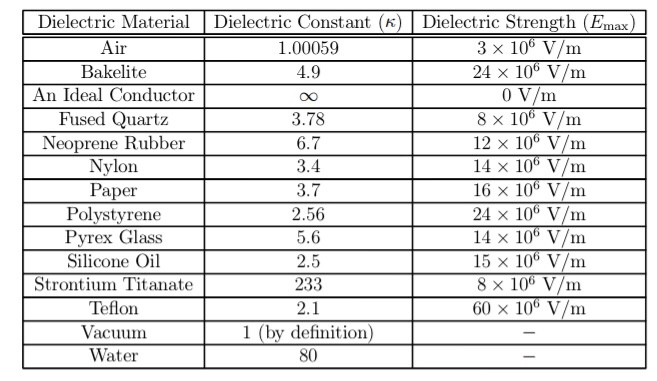32 53 2016 abstract this review describes electrical and dielectric measurements of rubbery polymers.
Dielectric constant of neoprene rubber.
As indicated by e r 1 00000 for a vacuum all values are relative to a vacuum.
A high dielectric constant indicates that the material is highly insulating.
Dielectric constant or permittivity is a measure of how well the insulating material will act as a dielectric capacitor.
Relative permittivity is the factor by which the electric field between the charges is decreased relative to vacuum.
Dielectric constant is a measure of the charge retention capacity of a medium.
Values of the dielectric constant κ for various materials are given in table 1.
Note that κ for vacuum is exactly 1 and so the above equation is valid in that case too.
The capacitance created by the presence of the material is directly related to the dielectric constant of the material.
Multiply by ε 0 8 8542 x 10 12 f m permittivity of free space to obtain absolute permittivity.
Air 1 1 amber 2 6 2 7 asbestos fiber 3 1 4 8 bakelite 5 22 barium titanate 100 1250 beeswax 2 4 2 8 cambric 4 4 carbon tetrachloride 2 17 2 17 celluloid 4 4 cellulose acetate 2 9 4 5 durite 4 7 5 1 ebonite 2 7 2 7 epoxy resin 3 4 3 7 ethyl alcohol 6 5 25 fiber 5 5.
Rubber sheeting cloth inserted neoprene.
If a dielectric is used perhaps by placing teflon between the plates of the capacitor in example 1 then the capacitance is greater by the factor κ which for teflon is 2 1.
Email this page download pdf download pdf printable page.
Roland naval research laboratory chemistry division code 6105 washington dc 20375 rubber chemistry and technology vol.
C 6 7 x 8 85 x 10 12 f m x 1 50 m 0 0200 x 10 3 m 4 45 µf the stored charge is.
Key properties include thermal stability chemical stability electrical insulation and low toxicity.
Values presented here are relative dielectric constants relative permittivities.
The relative permittivity or dielectric constant of a material is its absolute permittivity expressed as a ratio relative to the vacuum permittivity.
Silicones are polymers with a si o si backbone.
In this case the dielectric material is neoprene rubber which has a dielectric constant of 6 7.
Dielectric constant k is a number relating the ability of a material to carry alternating current to the ability of vacuum to carry alternating current.
Main applications are flexible seals o rings etc.
The reinforcement makes it ideal for stress applications such as gaskets and diaphragm packings.
Electrical and dielectric properties of rubber c.
This constant is defined as the capacitance of the material in question compared by ratio with the capacitance of a vacuum.
Permittivity is a material property that affects the coulomb force between two point charges in the material.

